Page 79 of 260

FALKEN
77
Tire Replacement
Falken recommends replacing your tires when the tread wears down
to the wear bars at 1.6mm (2/32 of an inch), which are located across
the tread in several locations around the tire. If only two tires are be\
ing
replaced, the two new tires should always be installed on the rear of
the vehicle to aid in preventing your vehicle from hydroplaning, even
if your car is front wheel drive. It’s always recommended to have your
new tires balanced during installation, and alignment checked if the
previous tires show and irregular wear. Tires that have been in use for
6 (six) years or more should continue to be inspected by a qualified tire
specialist, at least annually. It is recommended that any tires 10 (ten)
years old or older from the date of manufacture, including spare tires, \
be replaced with new tires as a precaution even if such tires appear
serviceable and even if they have not reached the legal worn out limit
at 1.6mm (2/32 of an inch).
Tire Repairs
In the event that you get a flat tire while driving, it is best to find a
nearby, safe place to stop and install your spare tire or call a tow truck.
The less distance that you drive on your low or flat tire, the better
chances your tire has of being repairable. Once you are able to get
to your local servicing tire dealer, have them dismount the tire from
the rim and thoroughly inspect the inside of the tire. It is important t\
o
know the difference between a proper tire repair and an improper one
because it can be critical to you and your vehicle’s safety. An improper
repair could pose a safety threat to you and your family and could
also affect your tire’s manufacturer warranty. Here are some tips in
determining if your damaged tire can be properly repaired or not:•
Always have the tire removed from the wheel and inspected before
any repair is performed.
•
Tires with less than 1.6mm (2/32 of an inch) of tread should NOT
be repaired.
•
Never repair a tire with a puncture larger than 6mm
(1/4 of an inch).
•
Repairs should be limited to the tread area only.
•
Repairs cannot overlap one another.
Page 108 of 260

KENDA
106
must be inspected by any tire dealer at once. Use of a damaged tire
could result in sudden tire destruction.
All tires will wear out faster when subjected to high speeds as well as
hard cornering, rapid starts, sudden stops, frequent driving on roads
which are in poor condition, and off road use. Roads with holes and
rocks or other objects can damage tires and cause misalignment of
your vehicle. When you drive on such roads, drive on them carefully
and slowly, and before driving at normal or highway speeds, examine
your tires for any damage, such as cuts or penetrations.
Worn Out Tires Are Dangerous
Tires contain ‘Wear-Bars” in the grooves of the tire tread which show
up when only 2/32nds of an inch (1.6mm) tread is remaining. At this
stage, your tires must be replaced. Tires worn beyond this stage
are dangerous.
Do Not Overload
Driving On Any Overloaded Tire Is Dangerous
The maximum load rating of your tires is marked on the tire sidewall.
Do not exceed these ratings. Follow the loading instructions of the
manufacturer of your vehicle and this will insure that your tires are no\
t
overloaded. Tires which are loaded beyond their maximum allowable
loads for the particular application will build up excessive heat that m\
ay
result in sudden tire destruction.
Do not exceed the gross axle weight ratings for any axle on your
vehicle. TRAILER TOWING
If you anticipate towing a trailer, you should see any tire dealer for
advice concerning the correct size of tire and pressures. Tire size
and pressures will depend upon the type and size of trailer and hitch
utilized, but in no case must the maximum cold inflation pressure of
tire load rating be exceeded. Check the tire placard and the owner’s
manual supplied by the manufacturer of your vehicle for further
recommendations on trailer towing.
Page 151 of 260

NITTO TIRE
149
The original usable tread is determined by measuring the depth on
the tread of an identical model of a new Nitto brand tire to the top of \
the treadwear indicator bars (note: the original usable tread depth will
vary by tire model).
The prorated cost of a replacement tire is determined as follows:
[(Original usable tread worn) ÷ (Original usable tread)]
x (Actual current dealer selling price).
A comparable Nitto brand tire is the same tire, or a tire of the
same basic construction and quality, as the original tire, as determined
by Nitto.
HOW TO MAKE A CLAIM
To make a claim under this Limited Warranty, you must: 1.
Present your vehicle with the subject tire(s), to an authorized
Nitto dealer.
2.
Complete and sign the Nitto Limited Warranty Claim form
provided by the dealer.
3.
Keep a copy of the Claim form for your records, and leave the
subject tire with the dealer.
Your claim will be administered in accordance with the limited warranty
that was in effect when you purchased the vehicle new.
YOUR LEGAL RIGHTS
This Limited Warranty gives you specific legal rights, and you may also
have other rights which vary from state to state.
LIMITATIONS AND EXCLUSIONS
NITTO DISCLAIMS ALL OTHER WARRANTIES, EXPRESS
OR IMPLIED, INCLUDING THE IMPLIED WARRANTY OF
MERCHANTABILITY, THE IMPLIED WARRANTY OF FITNESS FOR
A PARTICULAR PURPOSE, AND LIABILITY FOR INCIDENTAL
AND CONSEQUENTIAL DAMAGES (e.g., loss of time, loss of
use of vehicle, towing charges, road services, cost of rental car,
inconveniences, etc.).